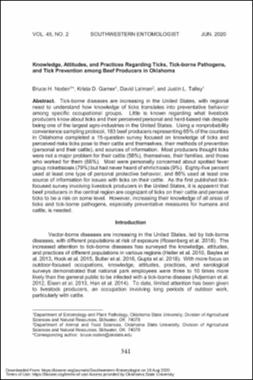| dc.contributor.author | Noden, Bruce H. | |
| dc.contributor.author | Garner, Krista D. | |
| dc.contributor.author | Lalman, David | |
| dc.contributor.author | Talley, Justin L. | |
| dc.date.accessioned | 2022-04-12T13:29:10Z | |
| dc.date.available | 2022-04-12T13:29:10Z | |
| dc.date.issued | 2020-06 | |
| dc.identifier | oksd_noden_knowledgeattitudesandpractices_2020 | |
| dc.identifier.citation | Noden, B. H., Garner, K. D., Lalman, D., & Talley, J. L. (2020). Knowledge, attitudes, and practices regarding ticks, tick-borne pathogens, and tick prevention among beef producers in Oklahoma. Southwestern Entomologist, 45(2), pp. 341-349. https://doi.org/10.3958/059.045.0202 | |
| dc.identifier.uri | https://hdl.handle.net/11244/335131 | |
| dc.description.abstract | Tick-borne diseases are increasing in the United States, with regional need to understand how knowledge of ticks translates into preventative behavior among specific occupational groups. Little is known regarding what livestock producers know about ticks and their perceived personal and herd-based risk despite being one of the largest agro-industries in the United States. Using a nonprobability convenience sampling protocol, 183 beef producers representing 65% of the counties in Oklahoma completed a 15-question survey focused on knowledge of ticks and perceived risks ticks pose to their cattle and themselves, their methods of prevention (personal and their cattle), and sources of information. Most producers thought ticks were not a major problem for their cattle (58%), themselves, their families, and those who worked for them (66%). Most were personally concerned about spotted fever group rickettsiosis (79%) but had never heard of ehrlichiosis (9%). Eighty-five percent used at least one type of personal protective behavior, and 86% used at least one source of information for issues with ticks on their cattle. As the first published tick-focused survey involving livestock producers in the United States, it is apparent that beef producers in the central region are cognizant of ticks on their cattle and perceive ticks to be a risk on some level. However, increasing their knowledge of all areas of ticks and tick-borne pathogens, especially preventative measures for humans and cattle, is needed. | |
| dc.format | application/pdf | |
| dc.language | en_US | |
| dc.publisher | Society of Southwestern Entomologists | |
| dc.relation.ispartof | Southwestern Entomologist, 45 (2) | |
| dc.rights | This material has been previously published. In the Oklahoma State University Library's institutional repository this version is made available through the open access principles and the terms of agreement/consent between the author(s) and the publisher. The permission policy on the use, reproduction or distribution of the material falls under fair use for educational, scholarship, and research purposes. Contact Digital Resources and Discovery Services at lib-dls@okstate.edu or 405-744-9161 for further information. | |
| dc.title | Knowledge, attitudes, and practices regarding ticks, tick-borne pathogens, and tick prevention among beef producers in Oklahoma | |
| dc.date.updated | 2022-04-07T14:08:32Z | |
| osu.filename | oksd_noden_knowledgeattitudesandpractices_2020.pdf | |
| dc.description.peerreview | Peer reviewed | |
| dc.identifier.doi | 10.3958/059.045.0202 | |
| dc.description.department | Entomology and Plant Pathology | |
| dc.description.department | Animal and Food Sciences | |
| dc.type.genre | Article | |
| dc.type.material | Text | |
| dc.subject.keywords | Prevention | |
| dc.subject.keywords | Rare Diseases | |
| dc.subject.keywords | Vector-Borne Diseases | |
| dc.subject.keywords | Infectious Diseases | |
| dc.subject.keywords | 0608 Zoology | |
| dc.subject.keywords | Entomology | |
| dc.identifier.author | ORCID: 0000-0002-0096-370X (Noden, BH) | |
| dc.identifier.author | ScopusID: 6601968347 (Noden, BH) | |
| dc.identifier.author | ScopusID: 57210554543 (Garner, KD) | |
| dc.identifier.author | ORCID: 0000-0002-1739-6238 (Lalman, D) | |
| dc.identifier.author | ScopusID: 6602750485 (Lalman, D) | |
| dc.identifier.author | ORCID: 0000-0002-2932-1866 (Talley, JL) | |
| dc.identifier.author | ScopusID: 55168292000 (Talley, JL) | |
